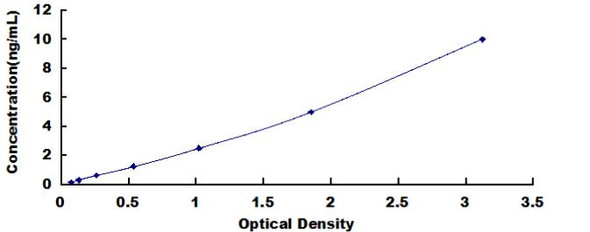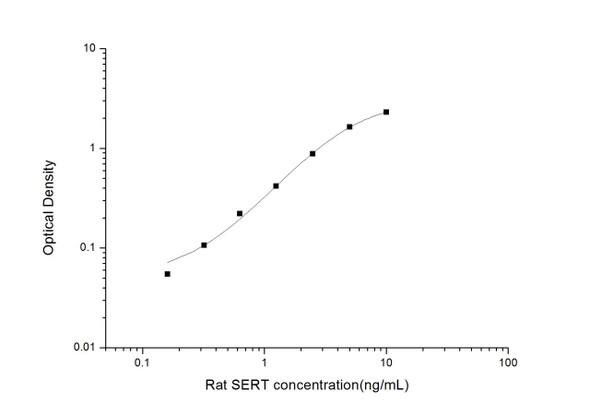Description
Human Serotonin Transporter/SERT ELISA Kit
The Human Serotonin Transporter (SERT) ELISA Kit is a reliable tool for the precise measurement of serotonin transporter levels in human serum, plasma, and cell culture supernatants. With a high level of sensitivity and specificity, this kit ensures accurate and reproducible results, making it suitable for a variety of research purposes.The serotonin transporter is a key protein involved in the reuptake of serotonin, a neurotransmitter that plays a vital role in mood regulation, behavior, and overall mental health. Dysregulation of the serotonin transporter has been linked to various psychiatric disorders such as depression, anxiety, and obsessive-compulsive disorder.
By accurately measuring serotonin transporter levels, researchers can gain valuable insights into the pathophysiology of these disorders and potentially identify new targets for therapeutic interventions. The Human SERT ELISA Kit is a valuable tool for studying the role of the serotonin transporter in health and disease, ultimately contributing to advancements in the field of neurobiology and mental health research.
| Product Name: | Human Serotonin Transporter / SERT ELISA Kit |
| Product Code: | HUFI02848 |
| Size: | 96 Assays |
| Alias: | SERT |
| Detection method: | Sandwich ELISA, Double Antibody |
| Application: | This immunoassay kit allows for the in vitro quantitative determination of Human SERT concentrations in serum plasma and other biological fluids. |
| Sensitivity: | 0.938pg/ml |
| Range: | 1.563-100pg/ml |
| Storage: | 4°C for 6 months |
| Note: | For Research Use Only |
| Recovery: | Matrices listed below were spiked with certain level of Human SERT and the recovery rates were calculated by comparing the measured value to the expected amount of Human SERT in samples. | ||||||||||||||||
| |||||||||||||||||
| Linearity: | The linearity of the kit was assayed by testing samples spiked with appropriate concentration of Human SERT and their serial dilutions. The results were demonstrated by the percentage of calculated concentration to the expected. | ||||||||||||||||
| |||||||||||||||||
| CV(%): | Intra-Assay: CV<8% Inter-Assay: CV<10% |
| Component | Quantity | Storage |
| ELISA Microplate (Dismountable) | 8×12 strips | 4°C for 6 months |
| Lyophilized Standard | 2 | 4°C/-20°C |
| Sample/Standard Dilution Buffer | 20ml | 4°C |
| Biotin-labeled Antibody(Concentrated) | 120ul | 4°C (Protect from light) |
| Antibody Dilution Buffer | 10ml | 4°C |
| HRP-Streptavidin Conjugate(SABC) | 120ul | 4°C (Protect from light) |
| SABC Dilution Buffer | 10ml | 4°C |
| TMB Substrate | 10ml | 4°C (Protect from light) |
| Stop Solution | 10ml | 4°C |
| Wash Buffer(25X) | 30ml | 4°C |
| Plate Sealer | 5 | - |
Other materials and equipment required:
- Microplate reader with 450 nm wavelength filter
- Multichannel Pipette, Pipette, microcentrifuge tubes and disposable pipette tips
- Incubator
- Deionized or distilled water
- Absorbent paper
- Buffer resevoir
| Uniprot | P31645 |
| UniProt Protein Function: | SERT: Serotonin transporter whose primary function in the central nervous system involves the regulation of serotonergic signaling via transport of serotonin molecules from the synaptic cleft back into the pre-synaptic terminal for re-utilization. Plays a key role in mediating regulation of the availability of serotonin to other receptors of serotonergic systems. Terminates the action of serotonin and recycles it in a sodium-dependent manner. Belongs to the sodium:neurotransmitter symporter (SNF) (TC 2.A.22) family. SLC6A4 subfamily. |
| UniProt Protein Details: | Protein type:Membrane protein, integral; Membrane protein, multi-pass; Transporter Chromosomal Location of Human Ortholog: 17q11.2 Cellular Component: neuron projection; integral to plasma membrane; plasma membrane; endomembrane system; endosome membrane; cytosol; lipid raft Molecular Function:actin filament binding; serotonin transmembrane transporter activity; protein binding; protein homodimerization activity; myosin binding; serotonin:sodium symporter activity; cocaine binding; syntaxin-1 binding; monoamine transmembrane transporter activity; nitric-oxide synthase binding; Rab GTPase binding Biological Process: circadian rhythm; response to drug; vasoconstriction; response to toxin; monoamine transport; positive regulation of cell cycle; social behavior; thalamus development; serotonin uptake; negative regulation of organ growth; negative regulation of synaptic transmission, dopaminergic; protein oligomerization; memory; response to estradiol stimulus; negative regulation of granule cell precursor proliferation; negative regulation of neuron differentiation; brain morphogenesis; response to hypoxia; sperm ejaculation; serotonin transport; transmembrane transport; protein homooligomerization; response to nutrient Disease: Anxiety; Obsessive-compulsive Disorder |
| NCBI Summary: | This gene encodes an integral membrane protein that transports the neurotransmitter serotonin from synaptic spaces into presynaptic neurons. The encoded protein terminates the action of serotonin and recycles it in a sodium-dependent manner. This protein is a target of psychomotor stimulants, such as amphetamines and cocaine, and is a member of the sodium:neurotransmitter symporter family. A repeat length polymorphism in the promoter of this gene has been shown to affect the rate of serotonin uptake and may play a role in sudden infant death syndrome, aggressive behavior in Alzheimer disease patients, and depression-susceptibility in people experiencing emotional trauma. [provided by RefSeq, Jul 2008] |
| UniProt Code: | P31645 |
| NCBI GenInfo Identifier: | 400630 |
| NCBI Gene ID: | 6532 |
| NCBI Accession: | P31645.1 |
| UniProt Secondary Accession: | P31645,Q5EE02, |
| UniProt Related Accession: | P31645,AAB26687 |
| Molecular Weight: | 74,979 Da |
| NCBI Full Name: | Sodium-dependent serotonin transporter |
| NCBI Synonym Full Names: | solute carrier family 6 (neurotransmitter transporter), member 4 |
| NCBI Official Symbol: | SLC6A4Â Â |
| NCBI Official Synonym Symbols: | HTT; 5HTT; OCD1; SERT; 5-HTT; SERT1; hSERT; 5-HTTLPRÂ Â |
| NCBI Protein Information: | sodium-dependent serotonin transporter; 5HT transporter; serotonin transporter 1; Na+/Cl- dependent serotonin transporter; 5-hydroxytryptamine (serotonin) transporter; solute carrier family 6 (neurotransmitter transporter, serotonin), member 4 |
| UniProt Protein Name: | Sodium-dependent serotonin transporter |
| UniProt Synonym Protein Names: | 5HT transporter; 5HTT; Solute carrier family 6 member 4 |
| UniProt Gene Name: | SLC6A4Â Â |
| UniProt Entry Name: | SC6A4_HUMAN |
*Note: Protocols are specific to each batch/lot. For the correct instructions please follow the protocol included in your kit.
Before adding to wells, equilibrate the SABC working solution and TMB substrate for at least 30 min at 37°C. When diluting samples and reagents, they must be mixed completely and evenly. It is recommended to plot a standard curve for each test.
| Step | Protocol |
| 1. | Set standard, test sample and control (zero) wells on the pre-coated plate respectively, and then, record their positions. It is recommended to measure each standard and sample in duplicate. Wash plate 2 times before adding standard, sample and control (zero) wells! |
| 2. | Aliquot 0.1ml standard solutions into the standard wells. |
| 3. | Add 0.1 ml of Sample / Standard dilution buffer into the control (zero) well. |
| 4. | Add 0.1 ml of properly diluted sample ( Human serum, plasma, tissue homogenates and other biological fluids.) into test sample wells. |
| 5. | Seal the plate with a cover and incubate at 37 °C for 90 min. |
| 6. | Remove the cover and discard the plate content, clap the plate on the absorbent filter papers or other absorbent material. Do NOT let the wells completely dry at any time. Wash plate X2. |
| 7. | Add 0.1 ml of Biotin- detection antibody working solution into the above wells (standard, test sample & zero wells). Add the solution at the bottom of each well without touching the side wall. |
| 8. | Seal the plate with a cover and incubate at 37°C for 60 min. |
| 9. | Remove the cover, and wash plate 3 times with Wash buffer. Let wash buffer rest in wells for 1 min between each wash. |
| 10. | Add 0.1 ml of SABC working solution into each well, cover the plate and incubate at 37°C for 30 min. |
| 11. | Remove the cover and wash plate 5 times with Wash buffer, and each time let the wash buffer stay in the wells for 1-2 min. |
| 12. | Add 90 µl of TMB substrate into each well, cover the plate and incubate at 37°C in dark within 10-20 min. (Note: This incubation time is for reference use only, the optimal time should be determined by end user.) And the shades of blue can be seen in the first 3-4 wells (with most concentrated standard solutions), the other wells show no obvious color. |
| 13. | Add 50 µl of Stop solution into each well and mix thoroughly. The color changes into yellow immediately. |
| 14. | Read the O.D. absorbance at 450 nm in a microplate reader immediately after adding the stop solution. |
When carrying out an ELISA assay it is important to prepare your samples in order to achieve the best possible results. Below we have a list of procedures for the preparation of samples for different sample types.
| Sample Type | Protocol |
| Serum | If using serum separator tubes, allow samples to clot for 30 minutes at room temperature. Centrifuge for 10 minutes at 1,000x g. Collect the serum fraction and assay promptly or aliquot and store the samples at -80°C. Avoid multiple freeze-thaw cycles. If serum separator tubes are not being used, allow samples to clot overnight at 2-8°C. Centrifuge for 10 minutes at 1,000x g. Remove serum and assay promptly or aliquot and store the samples at -80°C. Avoid multiple freeze-thaw cycles. |
| Plasma | Collect plasma using EDTA or heparin as an anticoagulant. Centrifuge samples at 4°C for 15 mins at 1000 × g within 30 mins of collection. Collect the plasma fraction and assay promptly or aliquot and store the samples at -80°C. Avoid multiple freeze-thaw cycles. Note: Over haemolysed samples are not suitable for use with this kit. |
| Urine & Cerebrospinal Fluid | Collect the urine (mid-stream) in a sterile container, centrifuge for 20 mins at 2000-3000 rpm. Remove supernatant and assay immediately. If any precipitation is detected, repeat the centrifugation step. A similar protocol can be used for cerebrospinal fluid. |
| Cell culture supernatant | Collect the cell culture media by pipette, followed by centrifugation at 4°C for 20 mins at 1500 rpm. Collect the clear supernatant and assay immediately. |
| Cell lysates | Solubilize cells in lysis buffer and allow to sit on ice for 30 minutes. Centrifuge tubes at 14,000 x g for 5 minutes to remove insoluble material. Aliquot the supernatant into a new tube and discard the remaining whole cell extract. Quantify total protein concentration using a total protein assay. Assay immediately or aliquot and store at ≤ -20 °C. |
| Tissue homogenates | The preparation of tissue homogenates will vary depending upon tissue type. Rinse tissue with 1X PBS to remove excess blood & homogenize in 20ml of 1X PBS (including protease inhibitors) and store overnight at ≤ -20°C. Two freeze-thaw cycles are required to break the cell membranes. To further disrupt the cell membranes you can sonicate the samples. Centrifuge homogenates for 5 mins at 5000xg. Remove the supernatant and assay immediately or aliquot and store at -20°C or -80°C. |
| Tissue lysates | Rinse tissue with PBS, cut into 1-2 mm pieces, and homogenize with a tissue homogenizer in PBS. Add an equal volume of RIPA buffer containing protease inhibitors and lyse tissues at room temperature for 30 minutes with gentle agitation. Centrifuge to remove debris. Quantify total protein concentration using a total protein assay. Assay immediately or aliquot and store at ≤ -20 °C. |
| Breast Milk | Collect milk samples and centrifuge at 10,000 x g for 60 min at 4°C. Aliquot the supernatant and assay. For long term use, store samples at -80°C. Minimize freeze/thaw cycles. |






